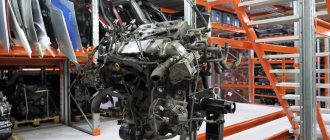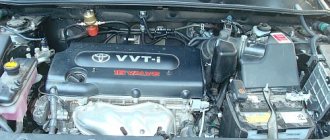The Toyota Corporation marked the beginning of the third millennium with the release of the first mass-produced diesel engine manufactured using Common Rail technology. Replacing the AD series, the 1CD-FTV engine is a 2.0-liter power unit, and is intended exclusively for use in the European automotive market. Hence the complaints about reliability and stability. But don't get ahead of yourself. Let's talk about everything in order.
1CD-FTV engine under the hood
Cars with Toyota D4D
Over the years of production of the Toyota D4D internal combustion engine, it was installed on the following cars:
Toyota Auris
- From September 2012 to June 2015 on a second generation Toyota Auris, station wagon, E180 body.
- From August 2012 to June 2015 on the second generation Toyota Auris, hatchback, E180 body.
- From July 2010 to November 2012 on the first generation Toyota Auris, restyling, three doors, hatchback, E150 body.
- From July 2010 to November 2012 on the first generation Toyota Auris, restyling, hatchback, E150 body.
- From October 2006 to July 2010 on the first generation Toyota Auris, three doors, hatchback, E150 body.
- From October 2006 to June 2010 on the first generation Toyota Auris, hatchback, E150 body.
Toyota Corolla
- From March 2021 to January 2021 on the eleventh generation Toyota Corolla, restyling, sedan, E180 body.
- From May 2012 to July 2021 on the eleventh generation Toyota Corolla, E180 body.
- From July 2010 to August 2013 on the tenth generation Toyota Corolla, restyling, sedan, E153 body.
- From November 2006 to June 2010 on the tenth generation Toyota Corolla, sedan, E150 body.
- From May 2004 to February 2007 on the ninth generation Toyota Corolla, restyling, three doors, hatchback, E120 body.
- From May 2004 to February 2007 on the ninth generation Toyota Corolla, restyling, hatchback, E120 body.
- From May 2004 to February 2007 on the ninth generation Toyota Corolla, restyling, sedan, E120 body.
- From May 2004 to February 2007 on the ninth generation Toyota Corolla, restyling, station wagon, E120 body.
Toyota Probox
- From July 2002 to August 2014 on a first generation Toyota Probox, station wagon, XP50 body.
- From July 2002 to August 2014 on a first generation Toyota Probox, station wagon, XP160 body.
Toyota Succeed
- From July 2002 to August 2014 on the first generation Toyota Succeed, station wagon, XP50 body.
- From July 2002 to August 2014 on the first generation Toyota Succeed, station wagon, XP160 body.
Toyota Yaris
- From December 2010 to June 2014 on the third generation Toyota Yaris, three doors, hatchback, XP130 body.
- From December 2010 to June 2014 on the third generation Toyota Yaris, hatchback, XP130 body.
- From January 2009 to December 2010 on the second generation Toyota Yaris, restyling, hatchback, XP90 body.
- From January 2009 to December 2010 on the second generation Toyota Yaris, restyling, three doors, hatchback, XP90 body.
- From October 2005 to December 2008 on the second generation Toyota Yaris, three doors, hatchback, XP90 body.
- From October 2005 to December 2008 on the second generation Toyota Yaris, hatchback, XP90 body.
- From March 2003 to October 2005 on the first generation Toyota Yaris, restyling, three doors, hatchback, XP10 body.
- From March 2003 to October 2005 on the first generation Toyota Yaris, restyling, hatchback, XP10 body.
- From January 1999 to February 2003 on the first generation Toyota Yaris, hatchback, XP10 body.
- From January 1999 to February 2003 on the first generation Toyota Yaris, three doors, hatchback, XP10 body.
Technical data
Toyota D4D is a four-stroke, diesel, 1.4 liter engine, the four cylinders of which are placed in one row. This engine has a different factory marking 1ND TV and has the following technical characteristics:
- serial production of Toyota D4D was carried out from 2002 to 2016;
- the cylinder block is made of aluminum, has an open cooling jacket, with wet cast iron liners;
- The cylinder head is made of aluminum alloy;
- SOHC type gas distribution mechanism, has one overhead camshaft and eight valves, 2 for each cylinder;
- the timing drive is carried out by a metal chain, hydraulic compensators are not provided here;
- diagram of the D4D fuel system, with Common Rail direct injection from Bosch;
- used high pressure fuel pump CP3S3;
- on internal combustion engines with a power of 70 hp, CT2 or CT9 turbines are used; on models with higher power, turbines with variable geometry GarretGT1444V or GT 1241 are used;
- The exact volume of the cylinders is 1364 cm3, cubic meters.
- compliance with European environmental requirements Euro 4, Euro 5;
- this engine has a piston stroke greater than the cylinder diameter of 81.5 and 73 mm, respectively. People call such internal combustion engines long-stroke. Their peculiarity is low load on the cylinder walls and piston group;
- The power of the power unit at 3000-4000 rpm ranges from 68 to 90 hp. And the torque at 2000-3000 rpm is 170 - 205 Nm.
- the compression ratio of the combustion chambers is from 16.5:1 to 17.9:1.
Options
The engine model in question has the following characteristics:
- engine capacity – 1995 cc;
- power - from 90 to 129 horsepower;
- torque – from 215 to 250 N*m;
- the fuel used is diesel fuel;
- direct fuel injection using Common Rail technology;
- the engine resource declared by the manufacturer is 200 thousand kilometers;
- recommended oil – 5W30, 5W40;
- compression ratio – 16.8-18.6;
- carbon dioxide emissions – 149-190 g/km.
Consumption
In combination with a five-speed manual gearbox installed on the Toyota Avensis T220, the 1CD-FTV engine has a fuel consumption of 8.1 l/100 in urban conditions and 5.6 l/100 on the highway.
Avensis sedan restyling
The six-speed manual transmission and 1CD-FTV power unit installed on the Toyota Avensis T250 give diesel consumption: 7.2 l/100 in the city and 4.9 l/100 outside the city.
At the same time, a Toyota Avensis Verso equipped with a 1CD-FTV engine and a five-speed manual gearbox consumes 8.1 l/100 in the city and 5.6 l/100 on the highway.
Toyota Avensis Verso
On the Toyota Corolla E120, in combination with a five-speed manual transmission, the power unit consumes no more than 5.7 l/100 in the combined cycle.
What Toyotas was it installed on?
The unit in question was installed on the model:
- Avensis T220 (from 1999 to 2003), Avensis T250 (from 2003 to 2006),
- Avensis Verso XM20 (from 2001 to 2006),
- Corolla E110 (from 2000 to 2002),
- Corolla E120 (from 2001 to 2007),
- Corolla Verso E121 (from 2001 to 2006),
- RAV4 XA20 (from 2000 to 2006),
- Previa XR30 (from 2001 to 2006).
Avensis T250 after update
Explanation of the name Toyota D4D
Japanese engines, like engines from other manufacturing countries, have a special naming formula, which can be used to obtain certain information about the engine in question. As for the Toyota 1.4 D4D, only the Toyota brand name, engine size and the name of the fuel system used on diesel engines, Common Rail, are indicated here. We're talking about D4D. This diesel equipment was developed by Denso, together with the Toyota Corporation. Toyota D4D was intended for use on cars, minibuses and light trucks.
This engine had a second name, factory 1ND TV, it had more encoded information. So, according to the rules adopted in Japan in 1987, in the first place there is a symbol in the form of a number indicating the generation of the internal combustion engine. Here, in the first place is 1, it indicates that this internal combustion engine is of the first generation.
Next, there are two symbols, in the form of Latin capital letters ND, they indicate the name of the family. The first of these, the letter N, denotes a line or series of engines. The second letter D, according to the 1996 diesel engine designation rules, indicates the diesel power of the engine. The next letter T indicates the use of turbocharging on the engine. Thus, on the motor in question with lower power, turbines controlled by a bypass valve were used. And on an internal combustion engine with a power of 90 hp, turbines with variable geometry were used.
The further symbol V is used only on diesel engines and indicates the use of a Common Rail fuel supply system from the well-known Bosch corporation.
If we put all the data together, we get a first-generation diesel engine of the ND family with turbocharging and a Common Rail fuel supply system.
Disadvantages of 1CD-FTV
Oddly enough, 1CD-FTV d4d does not contain technical mistakes in its design that are worthy of special mention. The traditional lack of repair dimensions makes the engine practically disposable, but this is rather a Toyota trademark.
What is the reason for the stories of some owners about “getting into expensive repairs”? Everything is very simple. The engine is intended for use in Europe. The quality of domestic diesel fuel is very unstable; it may contain water and mechanical inclusions. Once in the injection pump, the smallest foreign bodies are transformed into an excellent abrasive material. The result is a gradual loss of pressure in the fuel system, and then, as a systematic result, pump breakdown. Water, in the form of a finely dispersed mixture, blows away the nozzles with a bang.
Also, complaints are caused by the unstable operation of the sensor responsible for the oil pressure in the system. With standard indicators determined by the test pressure gauge, the sensor often signals an emergency situation.
Description of the Toyota D4D engine
A little history
At the beginning of the 21st century, the need for economical, reliable, environmentally friendly engines has increased. The 1.4 liter 1ND-TV met these criteria perfectly. It was developed for use on small-sized Toyota cars. Appeared in the serial production program in 2002. Although the first prototypes of this motor were assembled and submitted for testing in 1999.
History Toyota already had a small-displacement diesel engine 1N. Years of its production: 1989-1996. 1ND TV, in a certain sense, is its successor. But there are significant differences. So the 1N has a cast iron block, and the new engine is aluminum. The 1ND does not use a dual mass flywheel like the older model engine. But it uses a new Common Rail injection system, as well as a set of environmental equipment.
Over the years of production, the motor in question has gained a reputation as a sought-after, reliable and economical unit. But this does not mean that 1nd TV is not subject to any problems. The engine's operation was analyzed and improved.
So, the most serious modernization took place in 2008. The oil pump has changed its registration. Initially it was located in the valve cover, but then it was moved to the cylinder block and equipped with its own chain drive. Instead of reliable electromagnetic injectors, piezoelectric injectors were installed. Environmental equipment acquired a particulate filter and EGR, which contributed to the engine’s compliance with Euro 5 requirements. In 2012, engineers returned electromagnetic injectors to the engine design. Successful production of internal combustion engines continued until the end of 2021.
Device design features
1ND TV is the first small diesel engine with an aluminum cylinder block. The cooling jacket is open, similar to wet sleeves. The aluminum cylinder head has eight valves, two valves for each cylinder. SOHC timing mechanism with single overhead camshaft. Hydraulic compensators are not provided here. The timing drive is made by chain transmission. On models produced before 2008, the timing drive was carried out, in addition to driving the camshaft, by driving the oil pump, which was located in the cylinder head. After 2008, the oil pump was moved to the cylinder block. There he received his own chain drive from the crankshaft.
Features of fuel equipment
The D4D fuel equipment circuit is represented by a thirty-two-bit battery-type processor with a common rail (Common Rail). After the 2008 modernization, the time-tested, reliable electromagnetic injectors were replaced with piezoelectric ones, but four years later the electromagnetic injectors were again returned to the engine design. The engine is equipped with turbocharging and environmental equipment: an exhaust gas recirculation system, as well as a particulate filter.
Features of turbocharged 1ND TV
This engine is equipped with two types of turbines. Lower power models use turbos controlled by a wastegate. They come in two types: CT2 and CT9. Their heated part is combined with a manifold for exhaust gases.
On the 90 hp version of the engine in question, variable geometry turbines Garret GT1444Vс or Garret GT1241 series were installed. The control is carried out by an electric servo drive, supplied by Denso.
Environmental equipment
The D4D fuel system itself is an environmental equipment. From the start of production, the 1ND TV diesel engine complied with Euro 3 according to European environmental safety requirements. After 2008, the engine received an exhaust gas recirculation system, as well as a particulate filter, which contributed to the compliance of the internal combustion engine with Euro 4, Euro 5, depending on the electronics settings.
Features of fuel injection pump
The engine in question is equipped with a very reliable, durable Bosch CP3S3 fuel pump. In most cases, throughout the entire life of the internal combustion engine, owners forget about the presence of this part on the engine. This is because no problems happen to him. It takes a lot of effort to make the injection pump fail. This is possible if you regularly use dirty and low-quality diesel fuel. This, sooner or later, will lead to the formation of an abrasive coating on the pumping sections and their failure. The plungers will also suffer. With a long service life and severe frosts, fuel leakage may occur on the pump covers. The malfunction can be eliminated by replacing the sealing gaskets.
Modifications
In addition to the main engines, several modifications were born during the production process. Let's look at what they are and the changes:
- a version of the same engine with a smaller volume - 2.494cc, called 2KD-FTV;
- the base variant discussed below and used on the RAV4 CLA20;
- the 1CD-FTV variant on the Avensis features a conventional turbo, a vacuum-actuated EGR valve, a standard generator, a conventional belt tensioner and slightly less power;
- The 1CD-FTV variant on the Previa 30 is mainly distinguished by the presence of a gear-driven balancing mechanism.
Possible engine problems and ways to solve them
The 1ND TV engine is one of the few diesel power units with a small cylinder volume that does not have many characteristic malfunctions. However, there are still incompletely studied problems here. Here are the rare problems that occur with this engine:
Zhor oil
On the Internet you can find information about the most common problem of this internal combustion engine, which is increased oil consumption. Moreover, the reason for this is indicated, not wear of the piston rings, but a malfunction of the turbine. But if you look deeper into this problem, it will become clear. That the reason lies in the engine itself. Over time, the piston rings begin to leak gases from the combustion chamber into the crankcase. As a result of wear of the piston rings, high crankcase gas pressure is formed. They interfere with the draining of oil into the crankcase from the turbine. But the oil has to go somewhere. And it comes out through the shaft seal rings. The turbine begins to squeeze oil into the outlet and outlet not due to a malfunction of the turbocharger.
So, replacing the turbine in this case will not help. Worn piston rings are to blame for this situation. Replacing them will solve the problem with increased oil consumption.
Problems with the EGR valve
You can recognize them by the loss of power of the power unit. This is possible if the valve starts to slow down. The problem can be solved by cleaning the valve. But more often the issue is solved by plugging the valve and setting the electronics to work without EGR.
Fuel pressure
On the engine in question, there may be problems with the fuel pressure regulator valve. In this case, the engine starts poorly, does not develop full speed, and under load it may even stall.
Studying the design of this valve will help you understand the problem. If you take it apart, you can find a mesh that is clogged with lint from poor quality fuel filters. Cleaning the mesh may correct the problem. But it is better to install a new valve, as the needle may be worn out. Cleaning will not help in this case.
That's all the possible engine problems. Comparing them with possible malfunctions of other engines, we can conclude that this power unit is highly practical and reliable.
Malfunctions: diagnostics, repair
Problems with 1CD FTV motors include:
- Difficulty starting the engine at low air temperatures. The problem is complex. Repair requires installation of modified software in the control unit, rebuilding the starter and using a charged battery with increased starting parameters.
- The motor goes into emergency mode. At the same time, several indicators turn on on the instrument cluster. The cause of the breakdown is contamination of the exhaust gas recirculation system and damage to the injectors.
- Failure of the pedal position sensor, which disrupts the operation of the engine electronic equipment. If the sensor fails completely, the throttle closes the feed channel to the idle position. Determination of the malfunction is possible using diagnostic equipment; connection is made in accordance with the instructions for use. The sensor cannot be repaired; it is replaced with a new one.
- Vibrations during a sharp increase in speed indicate damage to the high-pressure pump or destruction of the support cushions. Repair consists of replacing components.
The oil pressure sensor periodically causes complaints. The device does not measure parameters correctly, giving false signals about an emergency pressure level. There are failures of temperature meters installed on the engine crankcase and in the control equipment. The malfunction is diagnosed by the scanner, the parts must be replaced.
- Breakdowns and malfunctions
Operational maintenance of 1ND TV
Proper maintenance of the power unit can extend its service life, and incorrect maintenance can significantly reduce it. Therefore, it is very important to carry out the following technical measures in a timely manner:
- The most common and important procedure when servicing an engine is replacing the engine lubricant. It must be performed every 10,000 kilometers. The oil volume in the engine is 4.8 liters; when replacing, you need to take 4.3 liters. Types of oil used by viscosity: 5w30 and 0w30. When changing the oil, you need to install a new oil filter;
- The timing chain drive, according to the manufacturer, has an unlimited resource. In reality, problems with the timing chain can begin after a mileage of 200 thousand km. Therefore, after this mileage has expired, the timing chain must be replaced with a new one;
- Valve adjustment must be performed after 100 thousand km. mileage. The adjustment procedure is very simple, using screws and locknuts;
- the attachment belt must be replaced after 100,000 kilometers;
- antifreeze, spark plugs and a filter in the fuel tank must be replaced after 80 thousand km;
- The fuel and air filters need to be changed after 20 and 10 thousand km, respectively.
Even a novice driver can perform these simple procedures. This will ensure long-term operation of a reliable power unit.
Advantages and disadvantages
Positive aspects of the engine:
- fuel consumption;
- low level of noise and vibration during operation;
- the ability to carry out major repairs with cylinder boring;
- The piston group resource is at least 300 thousand km.
Disadvantages of the power unit:
- long warm-up at ambient temperatures below -30ºС;
- drop in engine temperature when idling;
- expensive spare parts for the fuel supply system (injectors and pump);
- sensitivity to fuel quality.











